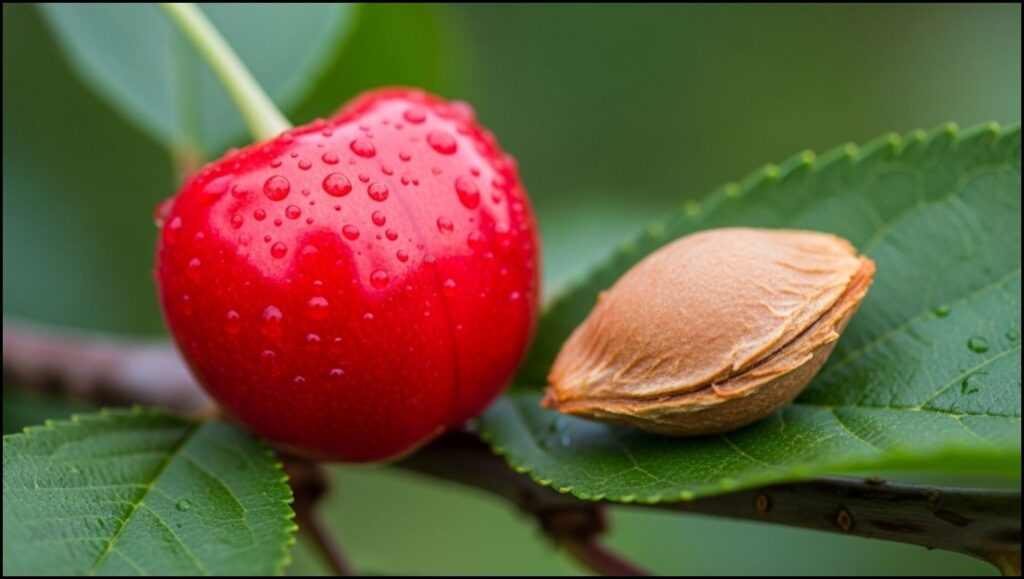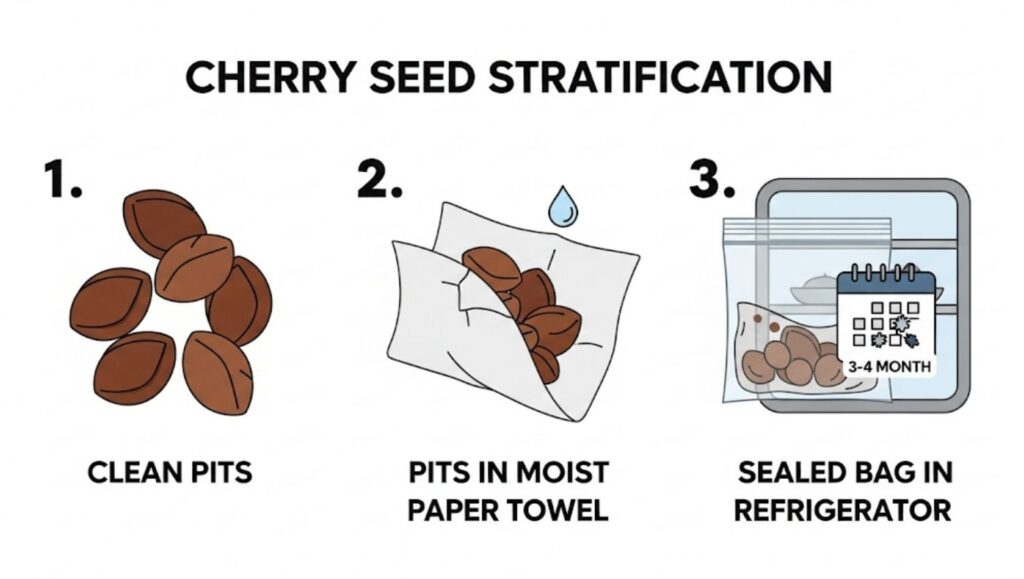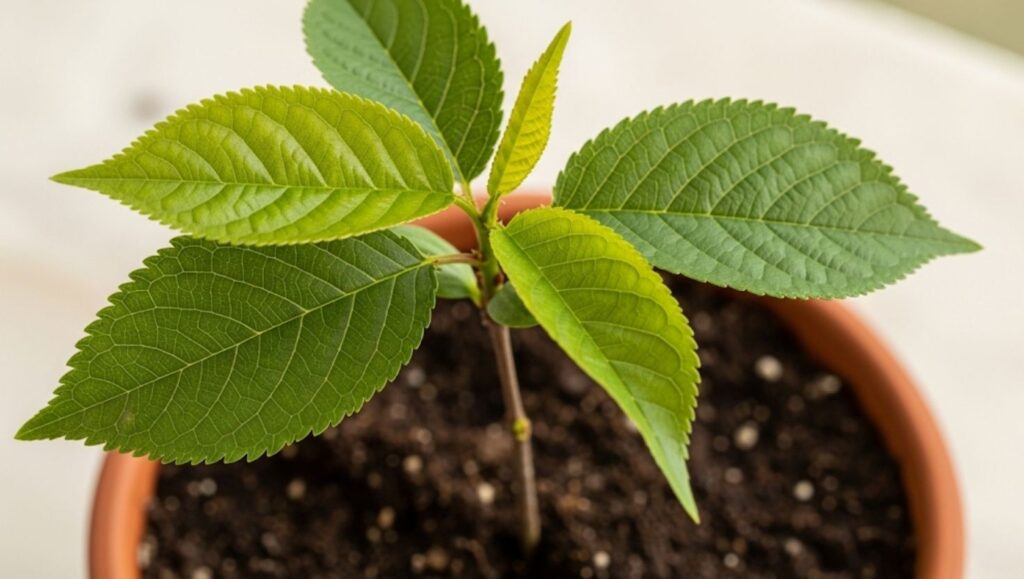
For gardeners seeking a project of patience and potential, the process of how to grow a cherry tree from a pit offers a unique connection to the food they eat. While purchasing a young tree from a nursery guarantees faster fruit, sprouting a seed from a summer cherry is a lesson in horticulture that, with the correct technique, can result in a new tree for a garden or landscape.
This guide provides a detailed, science-based approach to nurturing a cherry pit into a sapling, drawing on expertise from university agricultural extensions and horticultural professionals. It is a project that requires patience, with experts cautioning that the resulting tree may not produce fruit identical to its parent.
Key Facts for Gardeners
| Key Fact | Detail / Statistic |
| Genetic Variability | A seed-grown tree is a genetic individual and may not produce fruit “true-to-type.” The quality can vary significantly. |
| Critical Step | Cold stratification (a period of cold, moist storage) for 90-120 days is required to break the seed’s dormancy. |
| Time to Maturity | A cherry tree grown from a pit can take 7 to 10 years to produce its first fruit, if conditions are right. |
| Pollination Needs | Most sweet cherry varieties are not self-fertile and will require a second, compatible cherry tree nearby for pollination. |
Understanding the Challenge: Genetics and Patience
Before beginning, it is crucial to understand what growing from a pit entails. Commercially grown cherries come from trees where a desirable variety (like a Bing or Rainier) has been grafted onto a sturdy rootstock. This process clones the parent tree, guaranteeing the type and quality of the fruit.
A seed, however, is the result of sexual reproduction and contains a new combination of genes. “Think of it like having a child,” said Dr. Evelyn Reed, a horticulturist and author. “The child will have traits from its parents but won’t be an exact copy. A seed-grown cherry tree is the same; its fruit is a genetic lottery.”
This means the cherries from your new tree could be smaller, more tart, or simply different from the one you originally enjoyed. For many, the reward is the act of cultivation itself, not necessarily the harvest.
How to Grow a Cherry Tree from a Pit: The Step-by-Step Process
Success hinges on mimicking the natural conditions a seed would experience. This involves cleaning the pit, simulating winter, and then providing the right environment for growth.
Step 1: Selecting and Cleaning the Cherry Pits
The process begins with fresh fruit. Select pits from healthy, locally grown cherries when possible, as they are better adapted to your region’s climate. According to a guide from the University of California Agriculture and Natural Resources, pits from cherries purchased at a supermarket can work, but their origin and time in cold storage are unknown variables.
- Collect Pits: Gather about a dozen pits to increase the odds of successful germination.
- Clean Thoroughly: Remove all fruit pulp by scrubbing the pits in warm water with a soft brush. Any remaining flesh can lead to mold, which will prevent germination.
- Air Dry: Let the clean pits air dry on a paper towel for a few days in a well-ventilated area, but do not let them dry out completely for an extended period.
Step 2: The Critical Cold Stratification Period
This is the most essential phase for cherry seed germination. In nature, a cherry pit would fall to the ground and lie dormant through the winter. The cold, moist conditions signal the embryo to begin the process of sprouting once spring arrives. Gardeners must replicate this process, known as cold stratification.

“Without a proper cold stratification period, the growth inhibitors within the seed will not break down, and the seed will simply not sprout,” notes a publication from the Royal Horticultural Society (RHS).
- Prepare the Medium: Lightly dampen a paper towel or a small amount of sphagnum moss or sand. It should be moist, not waterlogged.
- Store the Pits: Place the clean pits in the moist medium, and seal them inside a plastic bag or small container. Label it with the date.
- Refrigerate: Place the container in a refrigerator (ideally between 34−41circF or 1−5circC) for three to four months. Check periodically to ensure the medium remains moist.
Step 3: Planting Cherry Pits and Awaiting Germination
After the cold period, it is time for planting cherry pits. Some seeds may have already begun to crack open or sprout in the refrigerator. These are the most viable.
- Prepare Pots: Fill individual 4-inch pots with a quality potting mix.
- Plant the Seeds: Plant one or two pits in each pot, about a half-inch deep.
- Provide Light and Water: Place the pots in a sunny windowsill that receives at least six hours of light per day. Keep the soil consistently moist but not waterlogged.
Germination should occur within a few weeks. Be patient, as different seeds will sprout on their own timeline.
Caring for Your Young Cherry Sapling
Once your seedling has several sets of true leaves and stands a few inches tall, it is a young tree. It will need consistent care to thrive.
- Watering: Keep the soil moist. Young trees are vulnerable to drying out.
- Light: Ensure it continues to receive ample sunlight.
- Transplanting: Once the seedling is robust and the risk of frost has passed, it can be transplanted to a larger pot or its permanent location outdoors. Choose a site with well-draining soil and full sun exposure.

The Long View: Pollination, Fruiting, and Varieties
Growing the tree is only half the journey. For it to bear fruit, most sweet cherry varieties like Bing, Lambert, and Rainier require cross-pollination. This means a second, genetically different but compatible cherry tree must be planted within 50-100 feet. Sour cherries, such as Montmorency, are often self-fertile.
If all conditions are met—including proper pollination, sufficient sun, water, and nutrients, and freedom from disease—you may see your first blossoms in 7 to 10 years.
The journey from a simple pit to a fruiting tree is a long-term commitment. While the outcome is uncertain, the process provides an intimate understanding of the life cycle of a tree, a reward that many gardeners find fulfilling in itself.
How to Plant Ginger Root: A Guide to Cultivating Culinary-Grade Flavor at Home
